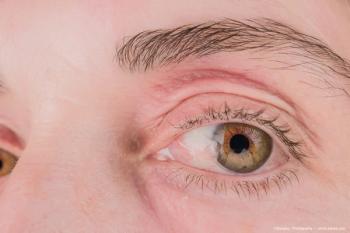
Bringing DALK application to forefront for corneal surgeons
Innovations in procedure may overcome current technical difficulty
Intraoperative OCT and the femtosecond laser may make deep anterior lamellar keratoplasty more consistently predictable.
Reviewed by Marjan Farid, MD
However, the difficulty of baring the Descemet’s membrane without perforating it using the big-bubble technique has limited DALK uptake by corneal surgeons.
Intraoperative
In the future, the femtosecond laser may also be used to precisely make a smooth deep lamellar dissection, thereby eliminating the need for the big-bubble, said
“Further exploration and advocacy are needed to bring these innovations in technology into the hands of every corneal surgeon,” Dr. Farid said.
Dr. Farid noted that application of the femtosecond laser to keratoplasty was pioneered by
The DALK technique involves use of the laser to create a zig-zag incision in both the host and donor tissue. The laser is programmed to perform a ring lamellar cut at a depth of 300 μm and with an inner diameter of 3 mm.
The technique allows the precise removal of 300 μm of the anterior stroma and enables visualization of the posterior cornea layers, thereby allowing more accurate needle insertion, and air injection.
The zig-zag cut also allows for better alignment of the graft and recipient tissues. Its use is associated with less astigmatism, higher-order aberrations, faster and stronger wound healing, and quicker visual recovery, Dr. Farid said.
Intraoperative OCT guidance offers another approach for enabling accurate needle placement when creating the big-bubble. Dr. Farid demonstrated its application with a video provided by Namrata Sharma, MD, Delhi, India.
“With intraoperative OCT, the surgeon is able to visualize Descemet’s membrane through the entire process, which decreases the risk of perforation, and also help with placement of viscoelastic and positioning of the scissors for the final cut,” she said.
RELATED:
Precise depth
Although the femtosecond laser can cut to a precise depth, the quality of the cut achieved using the laser for deep lamellar dissection has limited its application in DALK.
Dr. Farid explained that the organization of the collagen fibers differs in the posterior and anterior cornea, and initial efforts to use a femtosecond laser to create a smooth deeper cut resulted in a surface with ridges and irregularities that would degrade optical quality.
Dr. Farid presented evidence showing that a smooth cut was created using the technique in a human cadaver eye.
RELATED:
Disclosures:
Marjan Farid, MD
E:
Newsletter
Don’t miss out—get Ophthalmology Times updates on the latest clinical advancements and expert interviews, straight to your inbox.










































